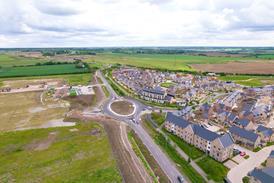Ahead of next week’s long-awaited Budget, Richard Whitehead explains why delivery must now match ambition if the UK is to realise its infrastructure promise
This government has delivered no shortage of defining policy moments during its time in office and this month’s Budget stands out as another critical milestone.

Over the past 18 months, the Treasury has laid the groundwork for growth rooted in a bold vision for infrastructure transformation across the UK. The reaffirmation of the UK’s 10-year infrastructure strategy and its £725bn national infrastructure pipeline, alongside commitments to housing and unlocking the planning system, sends a clear signal that infrastructure is central to Britain’s economic renewal.
The government must now grasp the nettle and deliver. We recently published a new report – Rebuilding Britain: Unlocking Growth from the UK’s Infrastructure Strategy – which sets out 10 steps we recommend the government can take to do just that.
The move from strategy to execution will be driven on three fronts: applying currently-overlooked practical steps to accelerate delivery; better embracing AI, data and innovation; and establishing a new approach to public-private partnerships.
Accelerate project delivery
The government has already acknowledged that infrastructure delivery remains too slow and fragmented, and has begun taking steps to tackle inefficiency. The creation of the National Infrastructure and Service Transformation Authority (NISTA) is a strong start.
However, without a dedicated minister with clear oversight of infrastructure policy, NISTA may lack the authority needed to turn strategy into delivery. A minister with deep industry experience – and proven insight into AI and innovation – should be responsible for driving coordination across departments, cutting through bureaucracy, and keeping delivery on track.
Crucially, they must ensure that NISTA has the resources and powers required to make a real difference.
The government could then demonstrate its impact by piloting simplified consenting and planning programmes through select schemes, setting a benchmark for best-in-class delivery and showing that faster, smarter planning is possible. I know that many across the industry would welcome the chance to see this change in action.
The government also has an opportunity to build on its planning reform to make sure the benefits are being felt in communities. A national-to-regional planning framework would help to break down silos and encourage co-location of complementary infrastructure.
A good example is thinking about how heat networks help new homes to repurpose waste heat from data centres or share cooling systems with nuclear facilities. These are practical ways to cut costs, reduce emissions and make investment go further.
Earlier investment into projects will also come as a result of this more joined-up approach, as investors, designers and consultants can see the through-line from project conception to completion, rather than tackling a scheme one stage at a time.
These are simpler steps, but they will complete the foundation which the government has already started to lay, and open up more possibilities to deliver faster and smarter.
Embrace AI-first infrastructure delivery
AI-usage is prolific across all sectors – infrastructure should not be any different and the government should adopt an AI-first approach to delivery. Digital tools and data need to sit at the heart of how projects are planned, delivered and maintained.
We have seen the impact already. Our work with the Environment Agency has shown how AI and real-time data can improve flood-risk modelling, giving teams better insights and faster response times.
Across the sector, integrating AI and digital twins can help to identify risks earlier, optimise resources and improve efficiency across the project lifecycle.
To make that happen, NISTA should be empowered to manage national infrastructure datasets. Shared, high-quality data would enable better collaboration, more informed decision-making and smarter policymaking.
In short, AI can bring the clarity, speed and certainty that modern infrastructure delivery demands.
Unlock private investment to enable smarter delivery
Ultimately, though, the challenge of how to fund projects is never far out of mind, and any efforts to accelerate delivery will fall short without the required resources. Unlocking private investment is essential.
There has been a vacuum since the end of the private finance initiative, but it is crucial that any new model takes instructive lessons and shows that taxpayer value for money is possible. That will be done by balancing risk and reward, protecting public value and attracting long-term private capital.
If this is a defining moment for this government, then it is the ideal time to take heed of what the industry needs and show that it can translate its vision into lasting value
We also need to strengthen capability within government. Acting as an intelligent client means building technical expertise, using digital assurance tools and creating clear, transparent pipelines that show which projects are ready for investment.
The Northumberland Line is a good example of what this can achieve. It is one of the UK’s largest third-party-funded rail upgrades, brought forward through collaboration between local government, industry and private finance. The project went from business case to an operational line in just five years, proving that partnership can accelerate delivery.
Changes like these – and at scale – won’t come about in next week’s Budget. But if this is a defining moment for this government, then it is the ideal time to take heed of what the industry needs and show that it can translate its vision into lasting value for communities, businesses and the economy.
Richard Whitehead is the chief executive of Aecom, Europe and India



























No comments yet